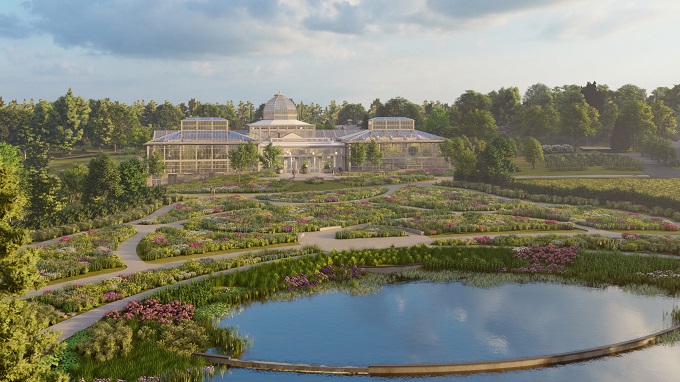Article featured on Richmond Bizsense
Two decades after its last major expansion, Lewis Ginter Botanical Garden is getting ready to grow again with a multimillion-dollar addition to its grounds and conservatory.
The garden is formally breaking ground this week on a $31 million expansion that will nearly double the size of the centerpiece conservatory, add over 7 acres of new gardens, and renovate and incorporate a second lake on the property.
The two-year project also will expand its Kroger Community Kitchen Garden, allowing for more produce to be grown for the regional food bank Feed More.
Years in the making, the expansion stems from a 2016 master plan for the 82-acre property in Henrico’s Lakeside. It’s being funded in part by a gift from an anonymous patron, along with funds raised through individual donations and the garden’s Thrive campaign that’s also getting underway.
CEO Brian Trader, who joined the garden in 2021, said fundraising for the conservatory expansion started five or six years ago but was slowed by the pandemic, which along with the leadership change put a lot of the planning for the project on pause.
Some other priorities identified in the master plan were combined with the conservancy to create the Thrive campaign, which Trader described as more than just new construction and grounds.
“To us, it’s not really what we’re building; it’s really about why we’re doing it,” Trader said. “We’re doing it to advance our collections, so that we can add new plants to the garden as a collection. Like a museum adds new pieces of art or works, our art is living, so the opportunity to expand our collections and advance those collections is really important as a botanical garden.”
Also driving the expansion is a need for more space to accommodate the garden’s growth in visitation and programming. When it last expanded in 2005 with the addition of its children’s garden, annual visitation at Lewis Ginter was at 124,000, Trader said.
“We’re pushing half a million now,” he said. “Our programming has grown, our staffing has grown, the number of volunteers has grown, the value that we provide to the community has grown, so it’s time for us to meet those needs in a better way.”
Plans call for an addition off the conservatory’s north side that will nearly double its current 11,000 square feet and add a permanent butterfly house. The garden’s Butterflies Live! exhibit, which is located on that side, will be closed this year and next due to the construction.
Also planned are 7.5 acres of new gardens beside the conservatory and the activation of Wick Lake, an existing lake that’s currently used for irrigation and closed to the public.
The project will add gardens to the hillsides next to the conservatory, increase Wick Lake’s size to 4 acres, convert part of it to a stormwater retention pond and add walking paths around and across it. The path around the lake, to be called Martha’s Way, is named for longtime board member Martha Sherman.
Educational areas and a meadow named for the late garden supporter Ann Lee Saunders Brown also are planned for the 15-acre project area that extends northwest of the conservatory. The expanded grounds will result in the glass-walled structure being more centrally positioned within the garden’s campus, which makes up 50 acres of the 82-acre property.
The expansion does not involve the 6-acre Lakeside Baptist Church property that the church has agreed to sell to the garden. Trader said plans for that property remain in the works.
The additional wildlife habitat will provide a “living classroom” that, along with other programming and educational opportunities, will contribute to the garden’s goals of lifelong learning and environmental sustainability, Trader said.
“That lifelong learning is a huge impetus, and it really ties to our mission very closely,” he said.
Designing the conservatory addition is local firm 3North, which also led the 2016 master plan and a recent renovation of the children’s garden treehouse. 3North founder Jay Hugo and project manager Ed Pillsbury said the addition will effectively reorient the structure, so it overlooks Wick Lake as well as the fountain garden between it and the visitor center building.
Hourigan is the general contractor for the addition, and Timmons Group is the engineer. The original structure was built in 2003 and designed by Richmond-based Glavé & Holmes.
3North is one of six landscape architects and designers on the project, along with Charlottesville-based Waterstreet Studio, Phyto Studio out of Arlington, Chicago-based Austin Eischeid, New York designer Wambui Ippolito and Arizona-based Catalina LaFrance. Trader said the designers were selected for their diverse backgrounds and to provide a variety of both garden designs and perspectives.
“Richmond’s a very diverse city, and it was really important for us as we were thinking about these new gardens that will engage our community and inspire our guests to make sure that there was diversity represented in those spaces as they were coming online,” Trader said. “Very intentionally we sought voices and backgrounds and experiences that haven’t been elevated previously in the garden.”
Fencing and initial site work for the project has become visible at the garden in recent weeks. Trader said the goal is to open the expanded conservatory and new gardens in spring 2026.
Trader noted the expansion is being funded primarily through private donations and does not involve the garden’s $10.8 million annual operating budget. While the garden does not receive operational support from the state, an amendment to the proposed state budget for next fiscal year includes $1 million for the project that year and $500,000 the following year. The budget has yet to be approved.
Trader said the expansion is not only adding to the garden but also represents an investment in the community.
“We are just very excited that we can have a bigger impact in the region and across the commonwealth. I hear very frequently in the community that the garden is a gem for Richmond, but when we look at where our guests are coming from, when we look at the schools that are coming here for formal programming, our reach is throughout the commonwealth,” he said. “We very much are the commonwealth’s botanical garden.”





